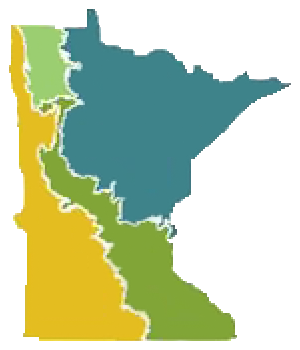Minnesota’s Biomes

What is a Biome?
A biome is a large area characterized by its vegetation, soil, climate, and wildlife. There are five major types of biomes: aquatic, grassland, forest, desert, and tundra, though some of these biomes can be further divided into more specific categories, such as freshwater, marine, savanna, tropical rainforest, temperate rainforest, and taiga.
Aquatic biomes include both freshwater and marine biomes. Freshwater biomes are bodies of water surrounded by land—such as ponds, rivers, and lakes—that have a salt content of less than one percent. Marine biomes cover close to three-quarters of Earth’s surface. Marine biomes include the ocean, coral reefs, and estuaries.
Grasslands are open regions that are dominated by grass and have a warm, dry climate. There are two types of grasslands: tropical grasslands (sometimes called savannas) and temperate grasslands. Savannas are found closer to the equator and can have a few scattered trees. They cover almost half of the continent of Africa, as well as areas of Australia, India, and South America. Temperate grasslands are found further away from the equator, in South Africa, Hungary, Argentina, Uruguay, North America, and Russia. They do not have any trees or shrubs, and receive less precipitation than savannas. Prairies and steppes are two types of temperate grasslands; prairies are characterized as having taller grasses, while steppes have shorter grasses.
Forests are dominated by trees, and cover about one-third of the Earth. Forests contain much of the world’s terrestrial biodiversity, including insects, birds, and mammals. The three major forest biomes are temperate forests, tropical forests, and boreal forests (also known as the taiga). These forest types occur at different latitudes, and therefore experience different climatic conditions. Tropical forests are warm, humid, and found close to the equator. Temperate forests are found at higher latitudes and experience all four seasons. Boreal forests are found at even higher latitudes, and have the coldest and driest climate, where precipitation occurs primarily in the form of snow.
Deserts are dry areas where rainfall is less than 50 centimeters (20 inches) per year. They cover around 20 percent of Earth’s surface. Deserts can be either cold or hot, although most of them are found in subtropical areas. Because of their extreme conditions, there is not as much biodiversity found in deserts as in other biomes. Any vegetation and wildlife living in a desert must have special adaptations for surviving in a dry environment. Desert wildlife consists primarily of reptiles and small mammals. Deserts can fall into four categories according to their geographic location or climatic conditions: hot and dry, semiarid, coastal, and cold.
A tundra has extremely inhospitable conditions, with the lowest measured temperatures of any of the five major biomes with average yearly temperatures ranging from -34 to 12 degrees Celsius (-29 to 54 degrees Fahrenheit). They also have a low amount of precipitation, just 15–25 centimeters (six to ten inches) per year, as well as poor quality soil nutrients and short summers. There are two types of tundra: arctic and alpine. The tundra does not have much biodiversity and vegetation is simple, including shrubs, grasses, mosses, and lichens. This is partly due to a frozen layer under the soil surface, called permafrost. The arctic tundra is found north of boreal forests and the alpine tundra is found on mountains where the altitude is too high for trees to survive. Any wildlife inhabiting the tundra must be adapted to its extreme conditions to survive.
The National Geographic Society is making this content available under a Creative Commons CC-BY-NC-SA license
National Geographic offers a cool tool to help you understand how biomes work! check it out!
Minnesota's Biomes
Big Woods, Big Rivers (including Aspen parkland)
The official name for the ecological province called Big Woods, Big Rivers by the Minnesota Master Naturalist Program is the Eastern Broadleaf Forest. Learn More »
Northwoods, Great Lakes
The official name for the ecological province called the Northwoods, Great Lakes by the Minnesota Master Naturalist Program is the Laurentian Mixed Forest. Learn More »
Prairies and Potholes
The official name for the ecological province called the Prairies & Potholes by the Minnesota Master Naturalist Program is the Prairie Parkland Province. Learn More »
